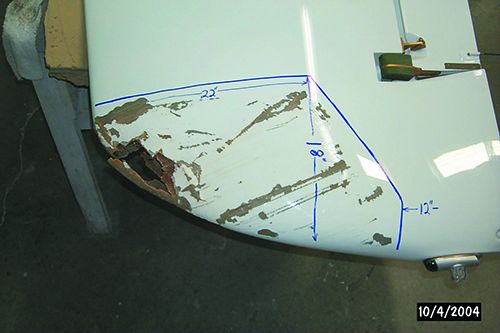Just like with metal airplanes there are a lot of things that can damage a composite one. Maybe it took an impact during ground handling, or a wildlife strike on the runway, or perhaps it’s dreaded hail damage, which requires lots of little (well, maybe big) repairs to the fuselage and control surfaces. Hey, stuff happens, and spotting these repairs—and how they were handled—is what you’re looking for when you’re shopping.
During our research we talked with Paul New at Tennessee Aircraft Services in Jackson, Tennessee, who specializes in major structural repairs to both metal and composite aircraft. New was handling the composite repair of a hail-damaged Cessna (Columbia) 300 in a way every buyer (and owner) would want, partly because Textron is involved in the process. The repair process for this Columbia—particularly the paperwork chase—is a poster child of how it should be done, in our view. The factory guidance is a Repair Definition.
New’s repair started with a detailed damage report sent to Textron, which will review the 27 impact points from the hail strikes that he found during his inspection. As New described it, every one of those impact points is considered a separate repair. The potential gotcha is that in certain areas of the structure, the number of repairs that are allowed is limited. Plus, repairs must not be too close in proximity to each other or they constitute a single and much larger repair. Here’s where the factory’s record-keeping is important because Textron maintains a structural map of all known repairs made to a particular composite Columbia, Corvalis and TTx series aircraft (all discontinued, of course, but still supported). These repair records will help determine if a new repair will encroach on any previous ones.
We attest that there are plenty of skilled composite shops that aren’t Textron, Cirrus or Diamond (to name a few models) service centers. On the other hand, if someone sidesteps the factory’s engineering of the repair (even when using a DER to orchestrate it and sign it off), they may be performing repairs in areas with previous damage and actually end up creating new structural issues. Moreover, a composite field repair made with assistance from the factory means there will be good records to support the repair, which should help the resale value.
As complicated as a composite structural repair seems, don’t overthink what’s really going on from a damage-repair standpoint. Or underestimate the skill and environmentally controlled shop space that’s needed to fix composite aircraft to like-new condition. Since composite structures have several layers of glass and cloth that must stay bonded together, almost any damage to the structure (beyond cosmetic) of a composite aircraft includes the separation of these critical layers. Perhaps overly simplified, it’s a sand, fill and paint process, albeit a pretty critical one.
New told us that for structural repairs to the Columbia, the Textron lab backstops it and gets a sample of a cured stamp (usually a bonded sandwich of structure) to verify that the resin was mixed and cured properly, and that the overall bonding mixture meets the correct specifications for structural integrity. The job isn’t finished until Textron essentially approves the field repair (and issues lab reports) and the shop signs an FAA Form 337 that’s kept with the aircraft records. The factory Repair Definition is considered approved data.
“Unlike metal airplanes, repairs to composite structure can be really difficult to spot, which is why I pay close attention to any composite airplane that comes in for a prepurchase evaluation,” New told us.
And that’s part of the takeaway. The inspection really needs to be done by someone who knows what they’re looking for. If the paperwork doesn’t reveal prior damage, a trained eye will. If the factory was involved and issued a Repair Definition, it was likely a good fix.





